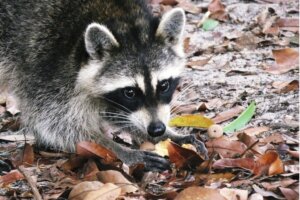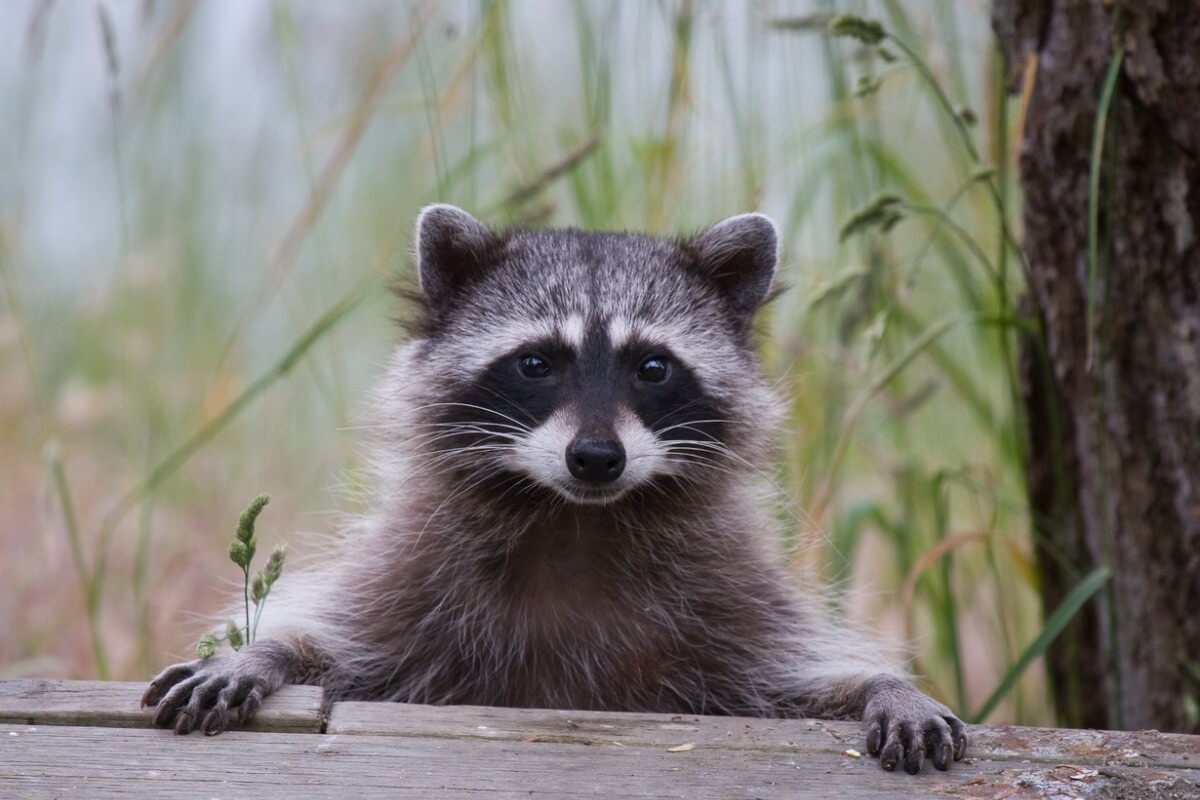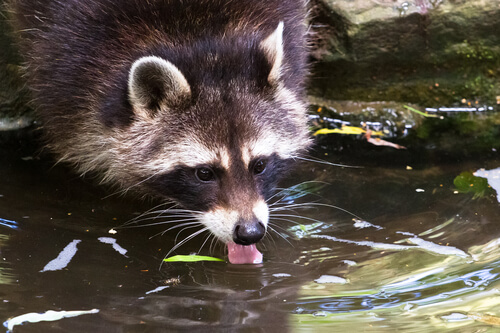The Raccoon: 5 Curious Facts


Written and verified by the biologist Cesar Paul Gonzalez Gonzalez
The raccoon is one of the most representative animals of the American continent. In spite of its size, it has a very endearing, attractive appearance. It also has a great capacity to adapt to different environments, which has led it to be considered an invasive species in certain countries.
Contrary to what it may seem, the term “raccoon” names several different species grouped in the genus Procyon. In addition, it belongs to the family Procyonidae, so it shares a kinship with cacomistles, coatis, and kinkajous. Continue reading and discover several curious facts about the raccoon.
What do raccoons look like?
Raccoons are characterized by having a small body of between 60 and 90 centimeters (23 to 35 inches) in length, with a tail that measures between 20 and 40 centimeters long (8 to 16) inches. While it’s true that their coloration doesn’t change much and only sports shades of gray and black, the color pattern is well known for displaying a ringed tail and a masked face.

The natural distribution of these animals includes several areas of deciduous or mixed forests, which usually have a body of water such as a river or lake. This last requirement is essential for the raccoon’s life, as it’s part of its well-known “washing” behavior.
Raccoon curiosities
Although raccoons are well-known animals in both America and Europe, here are some curious facts that most people are unaware of.
1. They have adapted to live with humans
One of the reasons why in America, and even in Europe, it’s normal to see raccoons near human populations is because they have adapted to live alongside people. In fact, to a certain extent, they live comfortably, as they eat the food waste that humans discard. In this way, raccoons don’t have to expend energy on predatory tactics.
This means that raccoons make very good use of human waste, which is why they prefer to live close to human populations. However, people perceive them as an unpleasant pest because they tend to scavenge in their garbage.
2. They don’t wash their food
One of the most well-known curious facts about raccoons is their well-known “washing” behavior, in which they submerge their food in water. In fact, in some places they’re also called “washing bears” because of this behavior. However, the purpose of this “washing” technique is not to clean their food.

A study published in the journal International Zoo Yearbook mentions that the “washing” of raccoons is actually a way to enhance the sensory experience of their food. Looked at another way, with this action, their hands are able to perceive the texture, weight, and shape of the food.
3. Their hands are quite sensitive
Raccoons’ hands have certain similarities to those of humans. Although they don’t have an opposable thumb, the distribution of their 5 fingers is ideal for them to be able to grasp and manipulate many objects. In fact, some studies have suggested that the nerves in their hands have a similar distribution to those of people, so they’re likely to be just as sensitive.
4. It has become an invasive species in Europe
The fur industry has had a preference for using raccoon skins, and they have generated hatcheries to meet the demand for their fur. The only problem is that this has caused them to conquer new areas outside the Americas, such as Europe. As a result, raccoons are now considered an invasive species.
5. Raccoons can be sociable creatures
Raccoons are known to be solitary and independent animals. This means that it’s rare to see several raccoons together at the same time. However, some research has shown that females break this stereotype, as they sometimes get together to share food and eat as a group.
As you can see, there are several curious facts about raccoons that can easily go unnoticed. Although it’s a popular animal, there are still some unknowns about its natural history. Because of this, it’s likely to surprise us with even more information or abilities.
The raccoon is one of the most representative animals of the American continent. In spite of its size, it has a very endearing, attractive appearance. It also has a great capacity to adapt to different environments, which has led it to be considered an invasive species in certain countries.
Contrary to what it may seem, the term “raccoon” names several different species grouped in the genus Procyon. In addition, it belongs to the family Procyonidae, so it shares a kinship with cacomistles, coatis, and kinkajous. Continue reading and discover several curious facts about the raccoon.
What do raccoons look like?
Raccoons are characterized by having a small body of between 60 and 90 centimeters (23 to 35 inches) in length, with a tail that measures between 20 and 40 centimeters long (8 to 16) inches. While it’s true that their coloration doesn’t change much and only sports shades of gray and black, the color pattern is well known for displaying a ringed tail and a masked face.

The natural distribution of these animals includes several areas of deciduous or mixed forests, which usually have a body of water such as a river or lake. This last requirement is essential for the raccoon’s life, as it’s part of its well-known “washing” behavior.
Raccoon curiosities
Although raccoons are well-known animals in both America and Europe, here are some curious facts that most people are unaware of.
1. They have adapted to live with humans
One of the reasons why in America, and even in Europe, it’s normal to see raccoons near human populations is because they have adapted to live alongside people. In fact, to a certain extent, they live comfortably, as they eat the food waste that humans discard. In this way, raccoons don’t have to expend energy on predatory tactics.
This means that raccoons make very good use of human waste, which is why they prefer to live close to human populations. However, people perceive them as an unpleasant pest because they tend to scavenge in their garbage.
2. They don’t wash their food
One of the most well-known curious facts about raccoons is their well-known “washing” behavior, in which they submerge their food in water. In fact, in some places they’re also called “washing bears” because of this behavior. However, the purpose of this “washing” technique is not to clean their food.

A study published in the journal International Zoo Yearbook mentions that the “washing” of raccoons is actually a way to enhance the sensory experience of their food. Looked at another way, with this action, their hands are able to perceive the texture, weight, and shape of the food.
3. Their hands are quite sensitive
Raccoons’ hands have certain similarities to those of humans. Although they don’t have an opposable thumb, the distribution of their 5 fingers is ideal for them to be able to grasp and manipulate many objects. In fact, some studies have suggested that the nerves in their hands have a similar distribution to those of people, so they’re likely to be just as sensitive.
4. It has become an invasive species in Europe
The fur industry has had a preference for using raccoon skins, and they have generated hatcheries to meet the demand for their fur. The only problem is that this has caused them to conquer new areas outside the Americas, such as Europe. As a result, raccoons are now considered an invasive species.
5. Raccoons can be sociable creatures
Raccoons are known to be solitary and independent animals. This means that it’s rare to see several raccoons together at the same time. However, some research has shown that females break this stereotype, as they sometimes get together to share food and eat as a group.
As you can see, there are several curious facts about raccoons that can easily go unnoticed. Although it’s a popular animal, there are still some unknowns about its natural history. Because of this, it’s likely to surprise us with even more information or abilities.
All cited sources were thoroughly reviewed by our team to ensure their quality, reliability, currency, and validity. The bibliography of this article was considered reliable and of academic or scientific accuracy.
- Smith, R. A., & Kennedy, M. L. (1987). Food habits of the racoon (Procyon lotor). J. Tenn. Acad. Sci, 62, 79-82.
- Whiteside, D. P. (2009). Nutrition and behavior of coatis and raccoons. Veterinary Clinics of North America: Exotic Animal Practice, 12(2), 187-195.
- Corman, L. (2011). Getting their hands dirty: Raccoons, freegans, and urban ‘trash.’. Journal for Critical Animal Studies, 9(3), 28-61.
- LYALL‐WATSON, M. A. L. C. O. L. M. (1963). A critical re‐examination of food “washing” behaviour in the raccoon (Procyon lotor Linn.). In Proceedings of the Zoological Society of London (Vol. 141, No. 2, pp. 371-393). Oxford, UK: Blackwell Publishing Ltd.
- Hirsch, B. T., Prange, S., Hauver, S. A., & Gehrt, S. D. (2013). Raccoon social networks and the potential for disease transmission. PLoS One, 8(10), e75830.
- Turnbull, B. G., & Rasmusson, D. D. (1986). Sensory innervation of the raccoon forepaw: 1. Receptor types in glabrous and hairy skin and deep tissue. Somatosensory research, 4(1), 43-62.
This text is provided for informational purposes only and does not replace consultation with a professional. If in doubt, consult your specialist.








